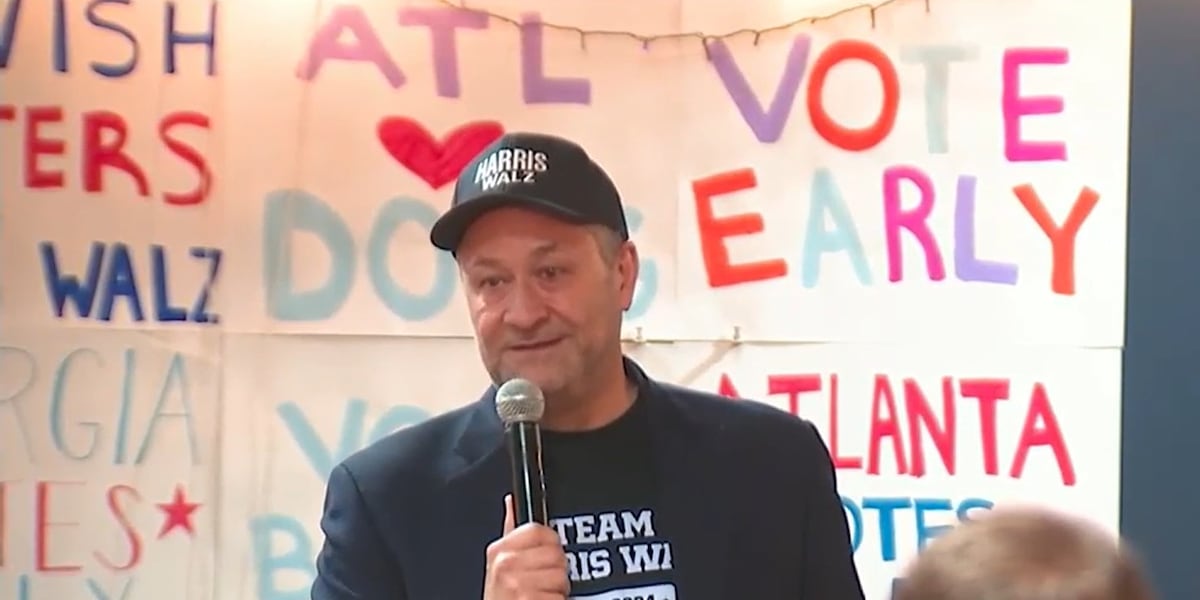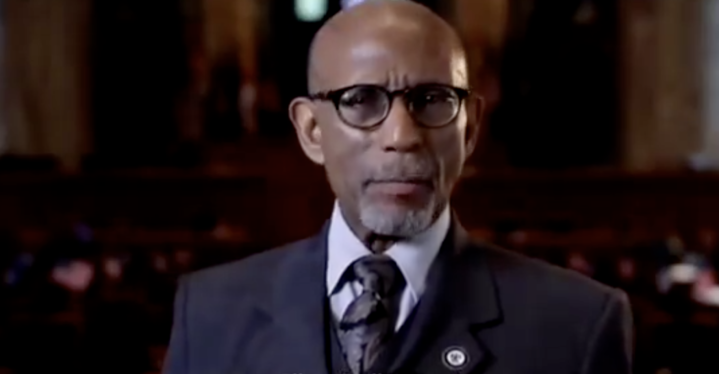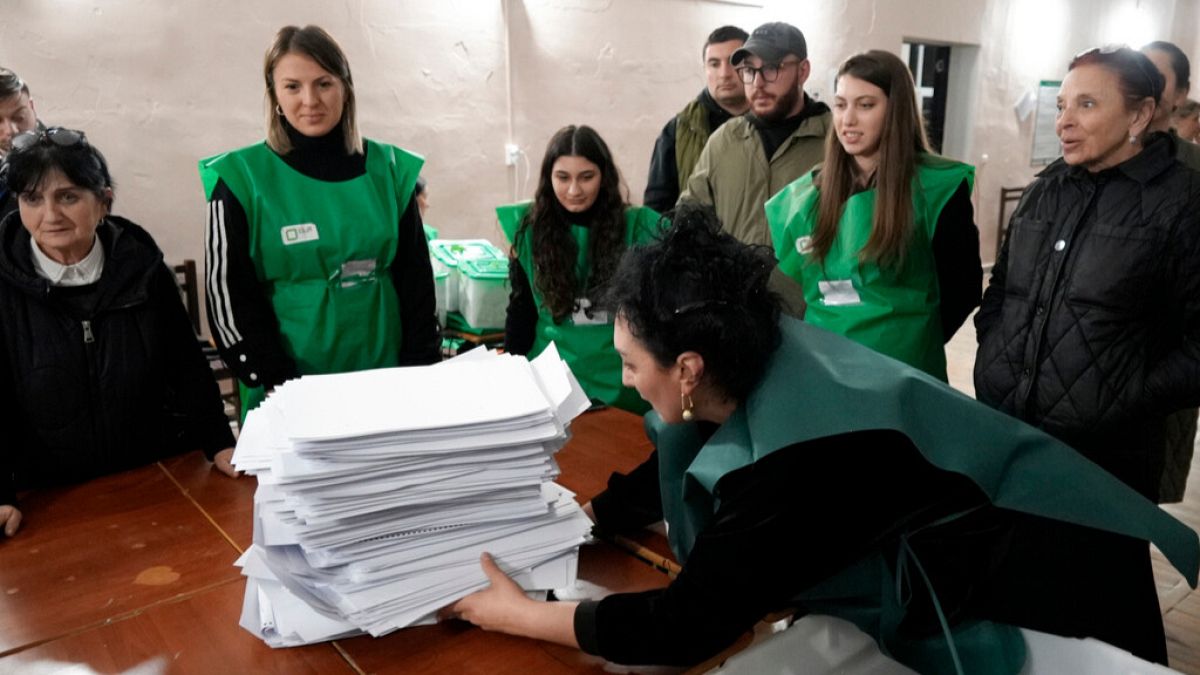Lifestyle
Lead in cinnamon: Where do things stand, 1 year after a scary recall?

The FDA issued three health alerts about lead in cinnamon in 2024, after dangerous amounts of the harmful element were found in children’s applesauce packets last fall.
FDA
hide caption
toggle caption
FDA
Last Halloween, the FDA flagged a worrying discovery: High levels of lead were found in applesauce pouches meant for young kids. Parents were alarmed, because the heavy metal can cause irreversible damage to babies and young children.
Within a month of the Halloween warning, the recall had widened and dozens of illnesses were reported in kids age 4 and younger.
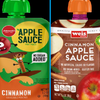
That was just the beginning: This year, the FDA issued three more public health alerts over lead in ground cinnamon, naming more than a dozen brands.
It’s a startling shift, as the FDA’s archives show no product recalls had been linked to lead and cinnamon for several years.
These recent alerts have prompted big questions for consumers: How and why did lead get into the cinnamon? Is it common? What can be done to prevent it from happening again?
Here are some answers.
Reports of more than 500 cases of elevated lead levels
State and local health departments have reported 519 cases of elevated blood lead levels linked to the pouches, the Centers for Disease Control and Prevention says, with 481 of those cases classified as confirmed or probable; lead exposure from other sources is suspected in the rest.
The cases were reported in all but six states (Alaska, Delaware, Hawaii, Maryland, Nevada and Wyoming), along with Washington, D.C., and Puerto Rico, according to the CDC.
The applesauce pouches in last fall’s recall were sold in the U.S. under three brand names: WanaBana (sold on Amazon and other websites, and at Family Dollar and Dollar Tree stores) and two grocery brands: Schnucks and Weis.

An image provided by the Food and Drug Administration shows the three recalled products: WanaBana Apple Cinnamon Fruit Puree pouches, Schnucks cinnamon-flavored applesauce pouches and variety pack and Weis cinnamon applesauce pouches.
Food and Drug Administration
hide caption
toggle caption
Food and Drug Administration

An image provided by the Food and Drug Administration shows the three recalled products: WanaBana Apple Cinnamon Fruit Puree pouches, Schnucks cinnamon-flavored applesauce pouches and variety pack and Weis cinnamon applesauce pouches.
Food and Drug Administration
That high-profile recall came after North Carolina officials investigating cases of children with elevated blood lead levels told the FDA that they identified apple cinnamon fruit puree pouches as the likely source. WanaBana USA initiated a voluntary recall, the FDA said.
Lead chromate is suspected
In last fall’s recall, “lead chromate was detected in the cinnamon collected from the manufacturer in Ecuador of the WanaBana apple fruit puree pouches,” an FDA spokesperson tells NPR. Lead routinely appears in foods due to its ubiquity in the environment. But the levels found in the puree raised both alarm and suspicion.
The recalled pouches “had between 2,270 ppm to 5,110 ppm lead in the cinnamon,” according to the FDA. For perspective: 5,000 parts per million is equal to 0.5%. That is thousands of times higher than U.S. thresholds to recommend a recall.
The agency believes the lead chromate was purposefully used as a color additive and categorizes it as a likely act of economically motivated adulteration, or EMA.
In paints and artists’ materials, lead chromate is known as “chrome yellow.” In the past, it’s been fraudulently added to spices to make their color more vivid so they look more fresh and flavorful.
“We’re aware of this practice in turmeric, where lead chromate has been added to enhance the color,” Laura Shumow, executive director of the American Spice Trade Association, tells NPR. But until last fall, her trade group had never heard of the pigment turning up in cinnamon, she says.

“That was really a very unusual incident,” Shumow says of the cinnamon fruit pouches. “Cinnamon is not typically traded for color. … So everything about that incident was very strange.”
Shumow says that no members of the American Spice Trade Association, which includes the majority of U.S. spice companies, were involved in any of the FDA recalls, and notes that both the cinnamon and the fruit puree pouches came from outside the U.S.
In Ecuador, the FDA says, a supplier named Negasmart sold cinnamon contaminated with lead chromate to the applesauce maker, Austrofood. Officials said the likely source of the contamination was a company named Carlos Aguilera, which processed the raw spice after it was imported from Sri Lanka. Ecuadoran authorities closed the business weeks after the initial recall.
Lead has damaging effects, especially in kids
“There is no level of exposure to lead that is known to be without harmful effects,” the World Health Organization says.
Lead spreads to the brain, liver, kidney and bones — and if a pregnancy occurs, lead is released along with calcium and can potentially harm the fetus.
“Children six years old and younger are most susceptible to the effects of lead,” the EPA says, adding that even at low levels, lead can cause lower IQ and hyperactivity, along with behavior problems and slowed growth.
While children absorb ingested lead more readily than adults, “The human body accumulates lead over a lifetime and normally releases it very slowly,” according to the federal Agency for Toxic Substances and Disease Registry, noting that bodies store lead in bones and teeth.
Lead chromate’s dangers are slightly different than those of lead. It’s a carcinogen that can affect the lungs and gastrointestinal tract, along with the liver, kidneys and immune system, according to the National Institutes of Health.
Families are suing, and coping with lead’s effects
For some families, the applesauce recall ended months of uncertainty over how their children had developed such high lead levels. Dozens of those parents are now suing.
“The good news is that most of the children’s blood lead levels have begun to decline since the recall,” attorney Nicholas Williams of Motley Rice, a law firm representing parents, tells NPR.
“That said, the levels of lead exposure pose significant concerns for the children’s future health and behavioral development, requiring continued monitoring from health professionals,” he adds.
In May, Florida-based WanaBana filed for Chapter 7 liquidation bankruptcy, complicating parents’ hopes for restitution. As of now, Williams says, parents are pursuing claims — both personal injury and class actions — against companies in the manufacturing and distribution chain.
More alerts in 2024, but with lower lead levels
The FDA has issued three public health alerts in 2024 for ground cinnamon, from brands such as Spice Class, Supreme Tradition, Marcum and La Frontera. The agency tells NPR that these products had far less lead than in the earlier recall, and lead chromate wasn’t detected.
Still, the FDA spokesperson says, the agency recommended a recall of products with “elevated lead levels ranging from 2.03 to 20 parts per million.”
Much of the ground cinnamon flagged by the FDA this year was sold by specialty international groceries. Discount stores such as Save-A-Lot and Dollar Tree were also affected.
Alarm over lead in cinnamon spiked again in September, when Consumer Reports said it found that 12 of the 36 cinnamon products it tested had more than “1 part per million of lead — the threshold that triggers a recall in New York,” the only U.S. state that regulates heavy metals in spices.

Cinnamon sticks from Sri Lanka were processed in Ecuador — where officials say lead chromate was added before the adulterated spice was packaged into applesauce pouches bound for the U.S. market. In this file photo, a Sri Lankan worker dries cinnamon quills at a peeling center in the Hikkaduwa region.
LAKRUWAN WANNIARACHCHI/AFP via Getty Images/AFP
hide caption
toggle caption
LAKRUWAN WANNIARACHCHI/AFP via Getty Images/AFP
Recalls highlight efforts to improve regulation
In the months after last fall’s bombshell recall, reports detailed how lead’s presence in applesauce reflects the difficulties of policing a complex supply chain that sends food to U.S. shelves.
The FDA says companies importing foods into the U.S. bear a legal responsibility to ensure the items are safe under U.S. laws and regulations.
“If the FDA determines that the level of lead causes the food to be unsafe, the agency will take regulatory action,” the agency says.
For years, American Spice Trade Association’s members have screened the spices they import for lead, Shumow says.
The small amounts of lead that come into spices naturally through the environment tend to fall below two parts per million, which is the organization’s guidance level of lead in cinnamon, she says.
She adds that while exporters such as India, Vietnam, Sri Lanka and China might have less rigorous regulations than the U.S., “we are a critical customer base for them,” motivating them to work to meet U.S. standards.
“Based on the FDA investigations and the Consumer Reports article, consumers of spices in the United States can be confident that the spices that they’re purchasing from reputable, well-known U.S. brands are safe and do fall below established thresholds of concern for lead,” Shumow says.
Zero tolerance isn’t possible — so what is?
“In reality, we don’t test products to be safe. We test it for the presence of the most-known bad things in it,” food fraud researcher John Spink says. “So for food safety, that’s about 30 or so bad bugs or chemicals.” Spink has seen peanut shells — a potential allergen — used as filler, and the industrial colorant Sudan Red used to make peppers more appealing. But in general, he says, the “vast majority of food fraud does not have a public health threat.”
When it comes to lead, a zero-tolerance policy isn’t practical, experts tell NPR, since it occurs naturally in the soil and water that nourish plants like cinnamon trees. Lead is also present in the environment due to its once-widespread use in paint and plumbing supplies, and gasoline.
The FDA says protecting the U.S. food supply is a main priority.
In 2023, the agency electronically screened 15 million food import lines, or shipments, with products coming from more than 200 countries. But it only physically examines a tiny fraction of that total, increasing its reliance on self-policing by industry.
“Food manufacturers and processors have the responsibility to take steps to ensure that the spices they manufacture are not contaminated with unsafe levels of heavy metals,” the FDA spokesperson says, citing the Federal Food, Drug, and Cosmetic Act and FDA regulations.
In the 2024 fiscal year, “FDA physically examined 50,135 lines and sampled 11,780 lines of human foods coming into the U.S.,” the spokesperson says. “While FDA physically examines less than 2% of shipments, we electronically screen 100% of all shipments and sample from the highest risk shipments.”
The FDA says it has only limited tools for reducing exposure to toxic elements such as lead in the food supply. It’s been asking Congress to give it new authority to establish binding contamination limits in foods, especially those consumed by infants and young children. But those efforts have not succeeded.
In the meantime, the agency has been working to update its guidance for levels of lead in foods meant for young children — a process that began more than two years ago. The FDA hopes to issue its final guidance in December.

Lifestyle
A Miami photo exhibit dispels myths about Haitian-American religious traditions

Photographer Woosler Delisfort documents ceremonies from vodou, ifa and santeria traditions actively practiced today
Woosler Delisfort
hide caption
toggle caption
Woosler Delisfort
Haitian-Americans have become the targets of disinformation and even hate this political season. Some of this is based on long-standing stereotypes and misunderstanding of their religious beliefs and spiritual practices.
A photo exhibition recently opened in Miami tries to shed some light on faith practices and ceremonies among Haitian-Americans and others that have connections to the Caribbean and Africa. The show, featuring work by photographer Woosler Delisfort, documents some of Miami’s vodou traditions.
The exhibition, “Sanctuary: Our Sacred Place” at HistoryMiami Museum showcases traditions actively practiced by communities throughout South Florida. Delisfort, a Haitian-American photographer who grew up in Little Haiti and was raised Catholic, became fascinated by the many ways people in his community expressed their spirituality. He says, “This is part of my culture. This is part of my tradition.”
Many of the nearly 150 photos in the exhibition focus on ceremonies from vodou, santeria and ifa traditions that have their origins among West Africa’s Yoruba people. All the images were captured in south Florida. He says, “There’s vodou ceremonies happening in Miami Shores, Pembroke Pines, West Miramar, the different places where you never would have thought… there’s ceremonies happening over here.”

Mambos, or priestesses in the vodou tradition circle a central post, a poto mitan
Woosler Delisfort
hide caption
toggle caption
Woosler Delisfort
In the gallery, one of Delisfort’s photos is of a vodou ceremony he attended in the backyard of a home in a Ft. Lauderdale suburb. A dozen women circle a decorated post called a poto mitan. “Most of these women are mambos,” he says. A mambo is a priestess in the vodou tradition. The poto mitan, Delisfort says, “is the charge between, the connection between the earthly world and… the ancestor world.”

Photographer Woosler Delisfort says for some Haitian-Americans, “Vodou is a way of life.”
Greg Allen, NPR
hide caption
toggle caption
Greg Allen, NPR
Delisfort says he was always was aware of vodou growing up and had friends and family who took part in its ceremonies and traditions. It’s about spirituality, he says but also about culture. Many who practice vodou he says, are observing Catholics or members of other Christian faiths. “At the end of the day,” he says, “vodou is a way of life. And that’s how most people view it. It’s a way of life.”

An altar, crafted by artist Michelle Murray, pays homage to the orisha, Yemaya
Greg Allen, NPR
hide caption
toggle caption
Greg Allen, NPR
An altar from the Yoruba ifa tradition is part of the exhibition. It’s covered with sea shells, fruit, flowers and other offerings to Yemaya, an orisha or divine spirit who’s considered the mother and embodies the oceans. It was created by Michelle Murray, a choreographer and ifa practitioner. She says there’s a lot of misunderstanding surrounding ifa, vodou and santeria. “People make it seem magical and mystical and demonized,” she says. “What we’re actually doing is taking care of the Earth and honoring all that comes with that.”
Another part of the exhibition documents a ceremony held on a Miami beach on Juneteenth every year at dawn. The show’s curator, Marie Vickles says practitioners of vodou, ifa and other faiths come together to send out on the water an offering of fruits, vegetables and flowers laid on a flotilla of palm fronds. Vickles says, “As it goes out, it’s meant to commemorate those who did not survive the middle passage, who were lost to the waters.” She says it also honors “those that made it and were able to create a new life here.”

A Catholic San Lazaro Day procession in Hialeah, Florida
Woosler Delisfort
hide caption
toggle caption
Woosler Delisfort
Other faiths and religious practices documented in Delisfort’s exhibition include Catholic San Lazaro Day and Ethiopian Orthodox Holy Week ceremonies, Santeria practices and Day of the Dead altars. They’re ceremonies not always open to outsiders. Delisfort spent years building relationships with religious leaders and practitioners and collaborated with them in this exhibition. Vickles says, “This is a project that not only celebrates spiritual practice, but also is documenting it for history, for the future. So, people can look back and say, ‘Oh, this existed in Miami,’ and hopefully still exists.”
Lifestyle
'Every time I wear this, they win': What 22 Dodger fans wore for the World Series

The last time the Dodgers were in the World Series, it was in the thick of the pandemic. So all the games were played at a neutral site in Arlington, Texas, and the capacity was capped at 25% of capacity. The big ‘fit that year was face masks.
Which is to say, Dodger fans weren’t able to show out in their usual way, showcasing a blanket of blue-and-white colors for their boys. This time around, they are getting their chance.
Dressing for a Dodgers game comes down to a simple formula. You have to make sure you’ve got enough blue. “Dodger Blue” is Pantone 294, a vibrant hue that is somewhere between perfect game-day sky blue and Pacific Ocean blue. Go any darker and you start to look like a Brewers fan. Add to that any item or accessory that says “L.A.” or “Dodgers” — “Doyers,” IYKYK.
Beyond that, make sure you’ve got that lucky piece on — if you aren’t wearing that puka shell necklace you wore the first time you sat in the nosebleeds during a midseason win back in 1997, and the Dodgers lose the Series this year? We’re not not saying that’s on you.
Here’s what 22 people wore to watch Game 1. We caught some of them outside Dodger Stadium while they headed to the game, and some at nearby bars.
Oscar Alexander Rodriguez and Angelica Andrade Martinez pose in front of the Fernando Valenzuela memorial at Dodger Stadium before the first World Series game on Friday in Los Angeles.
(Stella Kalinina / For The Times)
Oscar Alexander Rodriguez and Angelica Andrade Martinez
What part of town do you live in?
Oscar: East L.A.
Angelica: I work down the street. We are born and raised. I’m a mail carrier, so I know the Ravine.
What makes this outfit fit for the World Series?
Angelica: You have to wear your Converse. And I always wear my bow. Every time they play and I wear this, they win.
What’s your prediction for the World Series?
Angelica: I hope they win on Fernando Valenzuela’s birthday, which is Nov. 1. Go Dodgers!

Lizette Duenas poses in front of the Fernando Valenzuela memorial at Dodger Stadium before the first World Series game on Friday in Los Angeles.
(Stella Kalinina / For The Times)
Lizette Duenas
Where are you from?
I’m from Sonora. Fernando and me are from the same area. I was born exactly where he was born. I traveled 14 hours just to be here.
Why do you have on a Dodgers cap and Yankees jersey?
I wore both because I want both teams to be friends. Fernando hugs the Yankees, but the Dodgers are in my heart. Fernando said that baseball is just a game and that he wants everyone to be friends.
What’s your prediction for the World Series?
Neither. Both.

Jennifer and Miguel Guerrero pose in front of the Fernando Valenzuela memorial at Dodger Stadium before the first World Series game on Friday in Los Angeles.
(Stella Kalinina / For The Times)
Miguel and Jennifer Guerrero
Where are you from?
Jennifer: I’m from Riverside. During the Freeway Series, my parents are Angels, so I went for the Dodgers.
How long have you been a Dodger fan?
Jennifer: My whole life.
Miguel: Seven years.
Tell me about your husband’s chain.
Jennifer: We got it in Vegas. We got that and a Raiders one for me. He got that tattoo and he became a Dodgers fan because of me. I made him.
Are you wearing anything lucky for the Dodgers?
Jennifer: I’m wearing my old Kiké [Hernández] jersey. Every time I’ve been wearing it, they’ve been winning, so I wore this and not my Ohtani jersey.
Miguel: And I got a lucky Dodgers tattoo.
What’s your prediction for the World Series?
Miguel: Dodgers in 6.
Jennifer: I would say 6.

Andre and Margarita Daniels pose in front of the Fernando Valenzuela memorial at Dodger Stadium before the first World Series game on Friday.
(Stella Kalinina / For The Times)
Andre and Margarita Daniels
Where are you from?
Andre: I’m from L.A. I was raised in Watts. We live in Compton.
Tell me about your outfits.
Andre: She’s amazing. She puts together her own outfits. With me, I just had mine together already. I love my boots. My chain represents the Dodgers. Big Fernando fans as well. I grew up a Dodgers fan, so we’re just here to beat New York and hopefully take the World Series.

Andre and Margarita Daniels show off their Dodger-themed boots in front of the Fernando Valenzuela memorial at Dodger Stadium before the first World Series game on Friday.
(Stella Kalinina / For Los Angeles Times)
Are you wearing anything that is lucky?
Andre: Nothing lucky except my wedding band. [laughs] We’re just out here representing, wearing our colors. We just love being here.
Margarita: Well. Yes. I can’t tell you what it is.
What’s your prediction for the Series?
Margarita: I think that we will win in 4.
Andre: I’m predicting we take it in 6.

Alfonso, Christian and Gael Torres pose in front of the Fernando Valenzuela memorial at Dodger Stadium before the first World Series game on Friday.
(Stella Kalinina / For The Times)
Alfonso, Christian and Gael Torres
Where are you from?
Christian: We’re all from L.A. This is my dad and my brother.
Alfonso: I’ve been a Dodgers fan for 30 years. I was a young boy when Fernandomania happened in 1981.
Are you wearing anything that’s lucky?
Christian: The hat.
Have they won while you wore it?
Christian: No, not yet. Hopefully today they will.
What’s your prediction for the Series?
Christian: I think the Yankees are going to win.
Alfonso: Nooooo. Dodgers in 4.

Edilia Morales poses with her sons Raoul Aguilar, Edwin Aguilar and Allen Aguilar in front of a Dodgers mural on Friday.
(Stella Kalinina / For The Times)
Edilia Morales, Raoul Aguilar, Edwin Aguilar, Allen Aguilar
What part of town do you live in?
Edilia: East L.A.
Are you all big Dodger fans?
All: Yes!
Are you wearing anything lucky?
Edilia: Yes, the shirts.
Raoul: This jacket is a lucky jacket.
What is your prediction for the World Series?
Edilia: Dodgers in 8.
Raoul: Dodgers in 6 or 5.

Colby Wagenbach, left, and at right are Nikki Blizzard and Colby Wagenbach on Friday in Los Angeles.
(Stella Kalinina / For The Times)
Nikki Blizzard and Colby Wagenbach
Where do you live?
Colby: I’m living in Village Green.
Nikki: I’m living in Miracle Mile off La Brea, near the Grove.
Are you both big Dodger fans?
Nikki: I am now. I just moved to L.A. three months ago.
Colby: Lifelong Dodgers fan.
Where are you watching the game?
Colby: We originally were going to watch it at the Short Stop, but I think the crowd will be there after the game, so we’re going to go to the Douglas.
Are you wearing anything that is lucky for the Dodgers to win?
Nikki: I guess these pants are my lucky Dodger pants.
Colby: This shirt and the necklace — I had them both on the last time I went to a playoff game and they won. I wear the necklace every day, so I don’t know if it’s especially lucky.
What is your prediction for the Series?
Colby: Dodgers in 5.
Nikki: What he said.

Amy Farrar and Blair Paley show off their Dodgers style on Frida in Los Angeles.
(Stella Kalinina / For Los Angeles Times)
Amy Farrar and Blair Paley
What part of town are you in?
Amy: I live in Virgil Village.
Blair: I live in Echo Park just down the street.
How long have you been Dodger fans for?
Blair: Since I was born.
Amy: I guess since I moved here. Mostly, I really love the blue color.
Where did you find the hat?
Amy: The Instagram account is @methfountain. It’s this guy in New York that does plays on Birkin bags.

Blair Paley shows off her Dodgers hat on Friday in Los Angeles.
(Stella Kalinina / For The Times)
Are you wearing anything that is lucky for the Dodgers so that they win?
Blair: Not specifically only for the Dodgers. These boots are lucky, but not specifically for the Dodgers.
Amy: I want to believe that this child’s jacket that I found at a thrift store is lucky.
Not for the child. But for the Dodgers.
Amy: (Reads the name written on the tag) Poor Justin.
What’s your prediction for the Series?
Blair: The Dodgers are going to go all the way.
Amy: I think the Yankees are going to win two games.

Ralph Gomez and Kristen Hagen pose in their hot dog and glove costumes on Friday in Los Angeles.
(Stella Kalinina / For The Times)
Ralph Gomez and Kristen Hagen
What part of town do you live in?
Ralph: I’m from L.A., born and raised. I live in Long Beach right now, but I was in Hollywood. I was born and raised in East Los Angeles.
Kristen: I live in Little Tokyo.
Is that why you’re a big Ohtani fan?
Kristen: Pretty much.
Have you been a Dodger fan since you were born?
Ralph: Definitely. Rest in peace Fernando.
Is everybody in your family Dodger fans?
Ralph: Everybody is watching the game right now — my mom and dad.
I have to ask: You’re wearing a Dodger Dog?
Ralph: Yes, I am. Tomorrow I’m going to dress as Elton John.
How did you end up in this glove?
Kristen: I had it because when Ohtani was going to hit his 50th home run, we went to the game and I was going to be out there in the Pavilion trying to catch it, but he ended up hitting it at an away game.
Are you wearing anything that is lucky for the Dodgers to win?
Ralph: We have rally towels. The Short Stop is also the lucky place to watch the game.
Is this a lucky glove outfit?
Kristen: We’re going to find out tonight. Because this is the first time I’m wearing it for the entire game. If they lose, I’m never wearing it again. If they win, it’s staying in the rotation.
What’s your prediction for the Series?
Ralph: We’ll see today. The pitching is the thing that worries me, because the Yankees have a good lineup. If they pull today off, I’ll be feeling good. Dodgers in 7.
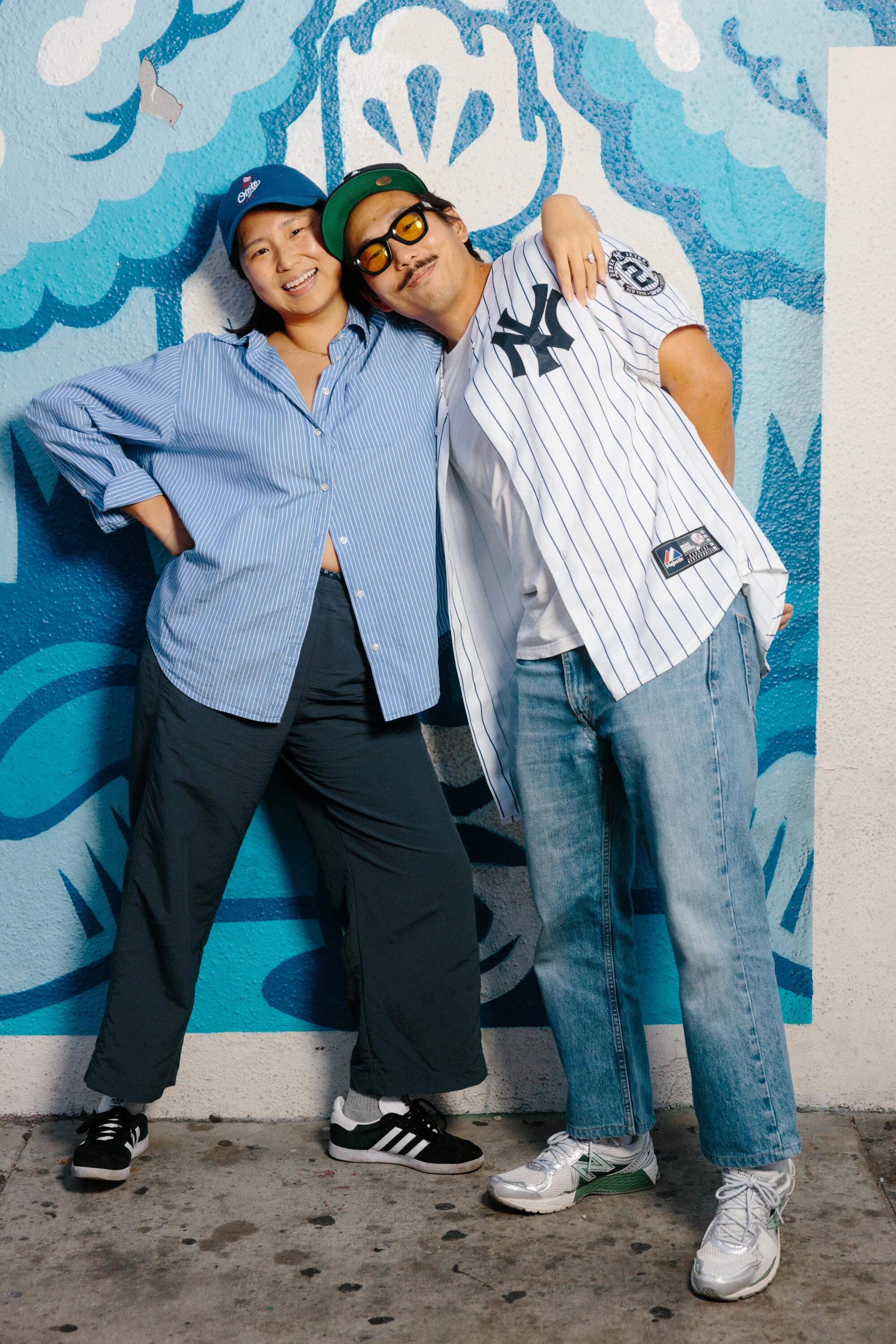
Christine Doh and Sean Yoo support opposing teams on Friday in Los Angeles.
(Stella Kalinina / For The Times)
Christine Doh and Sean Yoo
What part of town do you live in?
Christine: I’m in Glendale.
How long have you been a Dodger fan?
Christine: My whole life. Since I was born.
Who’s your favorite player?
Christine: Ohtani, obviously. I love Mookie Betts.
Tell me about the hat?
Christine: It’s a Japanese izakaya restaurant. They’re huge Dodger fans, and they created these hats six months ago. I had to get it.

Christine Doh shows off her unofficial Dodgers hat on Friday in Los Angeles.
(Stella Kalinina / For The Times)
And you’re wearing a Dodger blue shirt.
Christine: Just more repping. And it’s my personal uniform — blue is my favorite color. Navy is actually my favorite color, but that’s a Yankees color.
Why are you a Yankees fan?
Sean: I grew up in Jersey. It was the one team my dad instilled in me when I was growing up. But I’ve been in L.A. now for eight or nine years and I’ve adopted the Dodgers. I live in Echo Park, so it’s hard not to root for the Dodgers. I root for the Dodgers as much as I can except when they’re playing the Yankees.
Are you wearing anything lucky?
Sean: I’ve got a Derek Jeter jersey on. I have this classic Yankees 1943 World Series hat. Nothing super lucky, but stuff that makes me stick out as a Yankee fan.
What’s your prediction for the Series?
Christine: Dodgers are going to take it in 5.
Sean: Yankees in 6.
Lifestyle
How to buy cheap(er) Broadway tickets

Robert Downey Jr. is on Broadway this fall.
Matthew Murphy and Evan Zimmerman/Lincoln Center Theater
hide caption
toggle caption
Matthew Murphy and Evan Zimmerman/Lincoln Center Theater
It’s the time of year when people think about visiting New York City for the holidays — and maybe seeing a Broadway show. It’s an exciting season to do that, since celebrities are all over Broadway this year (Robert Downey Jr. is on stage until after Thanksgiving; George Clooney’s coming this spring. But there’s also Jim Parsons, Mia Farrow, Daniel Dae Kim, Kit Connor…).
Then again — you may be scared away by stories about $800 tickets.
As a former theater critic and a long-time arts reporter, the question I’m asked most often is: How can I get affordable tickets? I’ve steered friends, relatives and colleagues toward cheaper (if never cheap) seats. Here’s my best advice:
Be flexible, if you can.
Do you want to see a particular show (you’re a Sondheim fanatic, there’s a celebrity you love) or is it just that a Broadway show is on your bucket list? Are you flexible on dates and times? Do you care where you sit? If you can be flexible, you’ll have a better chance at finding less expensive tickets. Not every ticket costs hundreds of dollars. There are plenty of options below $100 each, especially if you’re open to seeing almost anything, or at least a wide variety of shows.
Ticket prices change depending on the day, the capacity of the theater and the seat — pricing can be fluid and depend on weekly popularity of a show. If you can, check prices for a few days and compare. The difference could be significant.
And then there are the dead times of year: January, February and September. Those are great times to buy a Broadway ticket. During these months, you can look out for Broadway Week, which offers 2-for-1 tickets, and Kids’ Night on Broadway, when a child is free with an adult, usually in February.
And then there’s seat location. Seats with an obstructed view or partial view (you may not be able to see the whole stage) and seats that are in back of the highest balcony will cost you less.
Where to look
Shows that are in previews — that is, before their opening date, when they’re still working out kinks and haven’t been reviewed by the mainstream media — are often less expensive. Shows that are struggling are often sold for less. Long-running shows (Chicago), may be priced much lower than a show that just won Best Musical at the Tony Awards (The Outsiders). Plays often cost less than musicals (though not when there are super-famous people in them).
If you want to see how ticket prices are trending, you can check out the weekly Broadway grosses, put out by the Broadway League, which details how full a theater was the previous week. A show that’s at 70% capacity is going to have lower-priced tickets than a show that’s regularly at 100% capacity. And yes, that means it’s not as popular at the moment — but it doesn’t mean you’ll like it less!

Kit Connor and Rachel Zegler in Romeo + Juliet
Sam Levy/Romeo + Juliet
hide caption
toggle caption
Sam Levy/Romeo + Juliet
But what if your daughter really wants to see Kit Connor?
Are Broadway tickets ever sold at a discount? Yes. (Might not happen for this show, though!)
Discount codes: Discount codes are often available from New York Show Tickets, TheaterMania, BroadwayBox and Playbill. Some employers offer benefits like Working Advantage, which also has discounts. Some credit cards have special orchestra pricing. If you have a large family of 15 or more who are visiting and can book well in advance, you may be able to take advantage of group ticket pricing.
The lotteries: You can put your name in for tickets in advance and hope you’re the lucky winner – they usually run for one to four tickets and cost $30-40 per ticket. Bad news: you won’t be able to choose your tickets. Good news: most lotteries are now done online instead of waiting in line. Different productions use different lotteries, which may include TodayTix or Lucky Seat. Some lotteries are for the next day — others are for the next week — so you’ll need to visit the show website for details. You’ll have a very limited amount of time to respond if you’ve won, often about an hour, so be sure to check your email/texts regularly.
Rush tickets: Rush tickets are significantly discounted, day-of tickets. To buy them, go to the box office as soon as it opens on the day of the show (you may be able to get standing room tickets then, too.) These tickets are often taken from the remaining seats available, which means that you may not be able to sit with other members of your party. Pro tip: Buying tickets at the box office saves you ticketing fees, even if you are buying full-price tickets.
You can also buy discounted, same-day tickets through TodayTix or by going in person to one of TDF’s two locations: Duffy Square on Broadway at 47th St. in Times Square (look for the large red steps) or Lincoln Center (this one is inside the David Rubenstein Atrium, which makes it better for rainy days). Get there early, be prepared to wait in a long line, and (again!) be flexible.
Resale apps: Many resell sites hike up prices of tickets — though sometimes you can find cheap seats at the very last minute — if you are willing to wait it out. My colleague (and frequent theater-goer) Janet W. Lee recommends the ticket resell app Theatr, which sells for face value or less and often has last-minute deals.
See something Off Broadway — or wait for the road show
Many Broadway shows tour, probably to a place not far from your hometown. The sets may be scaled down, depending on the production, but the casts are terrific and the tickets cost considerably less. Or visit London! Though ticket prices even there have gone up, excellent seats for the most popular West End shows are around $150.
But also, consider Off Broadway! And Off Off Broadway! Some of the best theater in New York is not actually on Broadway, and the further you get from the Main Stem, the smaller and more intimate the experience and the less expensive the ticket. Productions that debut at the non-profit Off Broadway houses like the Public Theater and Second Stage often transfer to Broadway later, so you can tell all your friends, you “saw it when.” And commercial Off Broadway houses often have very popular, long-running shows that are worth seeing, like the current production of Little Shop of Horrors.
If you’re up for seeing Off Off Broadway shows, tickets can be as little as $11 with TDF’s “Go Off-Off and Beyond” membership, which has a one-time $5 fee.

Jim Parsons — and Katie Holmes and Zoey Deutch — are in Our Town on Broadway.
Daniel Rader/ Our Town
hide caption
toggle caption
Daniel Rader/ Our Town
For young theater-goers
There are many, many programs offering less expensive tickets for students or theatergoers under 35 or 40, including tickets in the $30-35 range at Roundabout, 2nd Stage, Lincoln Center, Manhattan Theatre Club, and Playwrights Horizons. Some shows, like The Outsiders, have special rush ticket rates for people under a certain age.
Tips for locals
If you live in the area, you have many more options. You can put your name in for several lotteries weekly and look out for Broadway Week and Kids’ Night on Broadway. If you work for a non-profit, are a student, union member, retiree, veteran, government worker or fall into many other categories, you can sign up for the excellent TDF membership program for $35 a year. Membership gives you the option of buying steeply discounted tickets for Broadway, Off Broadway and Off Off Broadway, with prices ranging from $11 to $60 each. Productions that are sold out will not show up on TDF, but it’s a great way to see shows in previews, shows drawing less of a crowd, or smaller (but often wonderful) productions.
If you don’t qualify for TDF, a good option is a “ticket papering service,” which discreetly fills seats for theaters (and often classical music or jazz concerts as well) to make them appear more popular. It’s simple — you sign up with a membership fee (usually around $100), pay a small fee (about $5 or so) per ticket, and go to the show on your best behavior. To find them, Google “ticket papering services” because they can come and go, but they include services like Play By Play, Theater Extras, Stagelight and Will Call Club. Ask around on social media sites like Reddit to see if a particular service generally has the kind of tickets that interest you.
And if you just want to see great theater and don’t care if it’s on Broadway? Consider a membership to one of the city’s excellent non-profit theaters, like the Public Theater, New York Theatre Workshop, Ars Nova or Atlantic Theater Company.
Story edited by Meghan Sullivan.
-

 Movie Reviews4 days ago
Movie Reviews4 days agoAlien Country (2024) – Movie Review
-
/cdn.vox-cdn.com/uploads/chorus_asset/file/25431700/STK201_SAM_ALTMAN_CVIRGINIA_A.jpg)
/cdn.vox-cdn.com/uploads/chorus_asset/file/25431700/STK201_SAM_ALTMAN_CVIRGINIA_A.jpg) Technology3 days ago
Technology3 days agoOpenAI plans to release its next big AI model by December
-

 Health2 days ago
Health2 days agoNew cervical cancer treatment approach could reduce risk of death by 40%, trial results show
-

 Culture3 days ago
Culture3 days agoTop 45 MLB free agents for 2024-25 with contract predictions, team fits: Will Soto get $600M+?
-
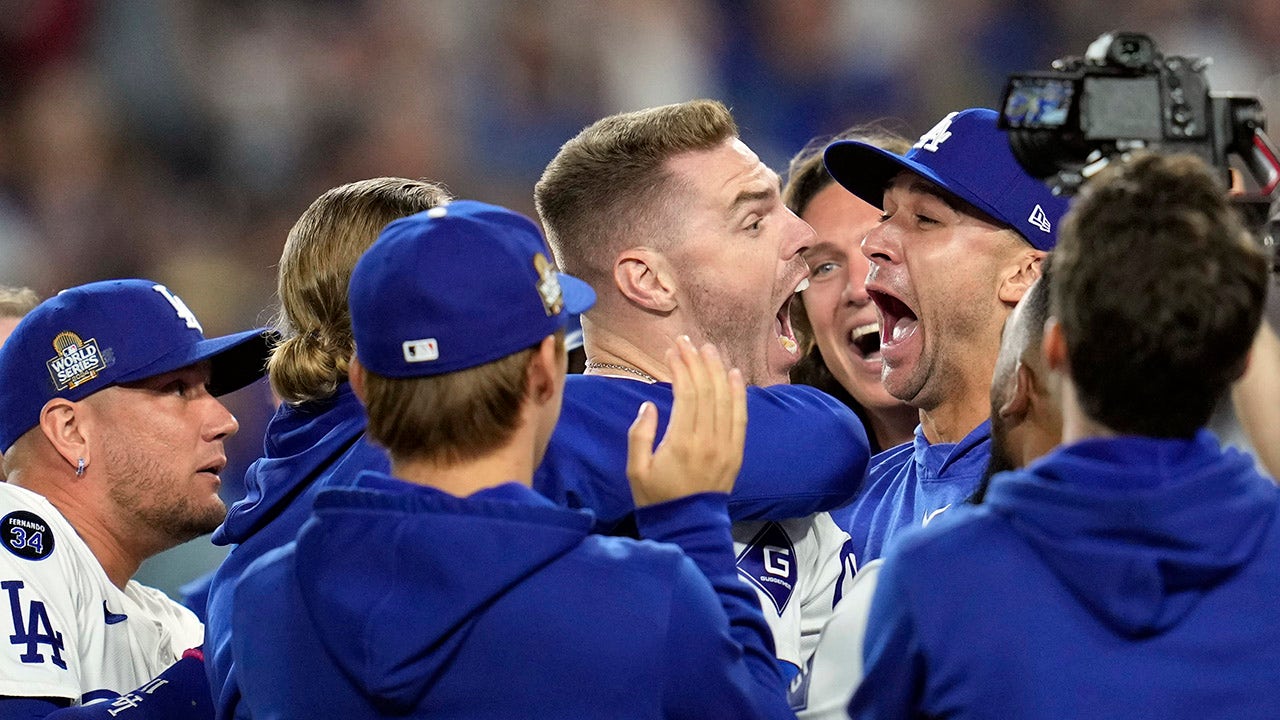
 Sports2 days ago
Sports2 days agoFreddie Freeman's walk-off grand slam gives Dodgers Game 1 World Series win vs. Yankees
-
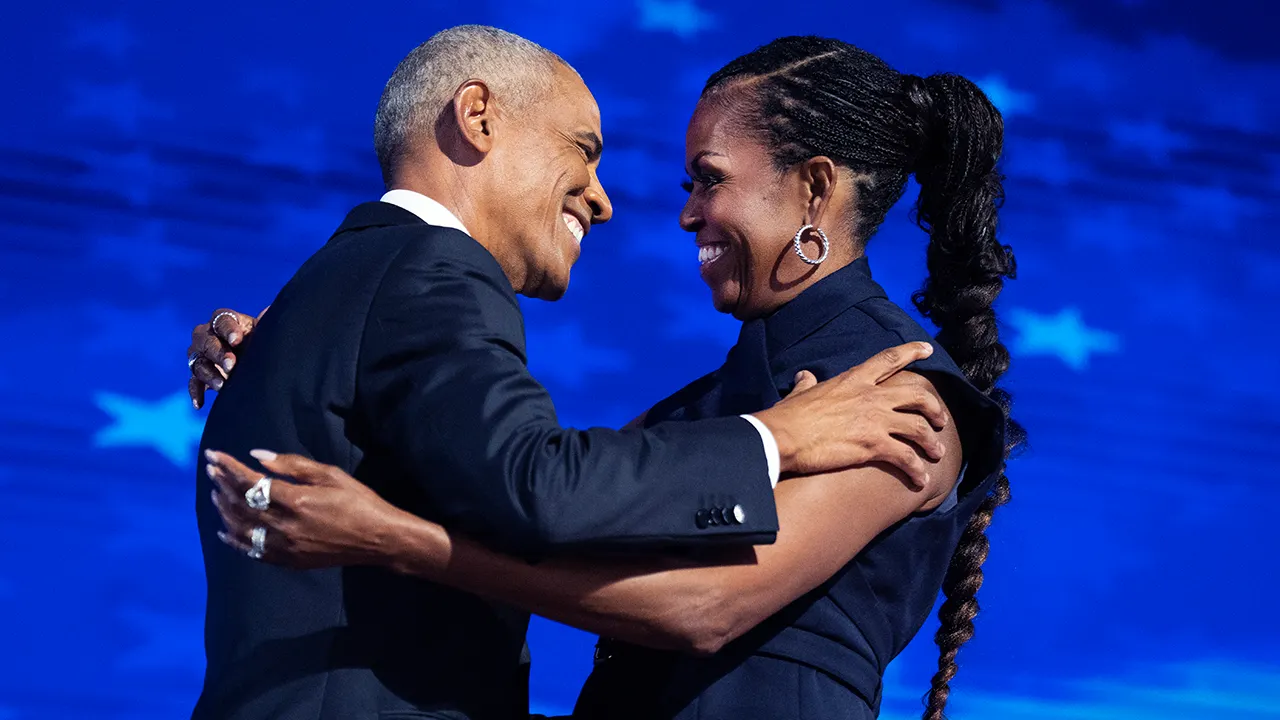
 Politics1 week ago
Politics1 week agoCrunch time: Harris to team up with Barack and Michelle Obama next week in key battlegrounds
-
News20 hours ago
Sikh separatist, targeted once for assassination, says India still trying to kill him
-

 News1 week ago
News1 week agoVideo: Trump Jabs Harris for Not Attending Al Smith Charity Dinner
